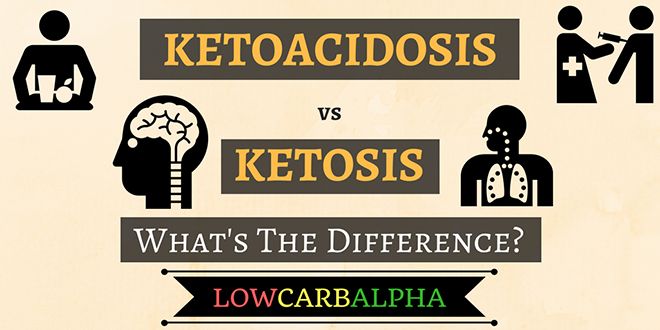This post may be sponsored or contain affiliate links. All opinions remain our own.(Full disclosure)

Although ketosis and ketoacidosis may sound the same, they are two distinct things.
We are going to be talking about the difference between ketoacidosis and ketosis and what makes the two diverse from one another.
In order to provide a good explanation of what these conditions are and how they affect the body, we must talk about their main common denominator, the ketones.
These are organic compounds that the body will provide when it starts to burn stored fat instead of burning glucose or sugar when it requires energy.

What is Ketoacidosis?
DKA applies to diabetic ketoacidosis and is a complication of type 1 diabetes.
Ketoacidosis is a very dangerous condition that makes it difficult for your body to be able to produce a good level of insulin.
Your levels of ketones can rise to very dangerous levels, which will also increase your blood sugar.
The ketones create a very acidic environment inside your body, and the function of certain organs will be affected severely.
It becomes a life-threatening situation when presented with high levels of ketones and excess blood sugar.
Anyone not given proper treatment for DKA could end up in a coma and even die.
The kidneys and liver are affected more than most other organs, and this can create a severe health issue.
Once a person develops what is known as diabetic ketoacidosis, they will show severe symptoms within as little as 24 hours.
When a person has type one diabetes, they are in great danger of developing diabetic ketoacidosis.

What is ketosis
The best way to explain ketosis is to consider it a very mild form of ketoacidosis, and the truth is that this is not going to be harmful most of the time.
In your lifestyle, if you’re on a ketogenic diet nutrition plan or any long-term low-carb diet, you might be experiencing ketosis.
The same effect can occur when you start to consume too much alcohol on keto leading to alcoholic ketoacidosis.
People who choose to start low carb, paleo or keto diets in order to lose weight fast possible may experience ketosis.
Naturally, a principal cause of ketosis is a lack of high carb foods such as sugars and starches over a period.
Those with diabetes are encouraged to check ketones in the urine and have to be careful not to take your ketogenic dieting to the extremes.

Ketosis and Ketoacidosis Symptoms
Some of the symptoms to look out for:
• Frequent need to urinate
• Nausea
• Lethargy
• Tiredness
• Shortness of breath
• Confusion
• Stomach pain
• Fruity Breath
If you are exhibiting any of these symptoms, you should check your blood sugar immediately. Consider seeking medical attention in order to find out if you have ketosis or diabetic ketoacidosis.
Other conditions can cause similar ketosis symptoms, so it is always a good idea to find out why this is happening.
Ketoacidosis Causes
Low-carb diets are the leading cause of ketosis. They produce less glucose in your blood, which will cause you to produce less insulin.
A diet low in calories can also cause ketosis since the body has a limited sugar supply.
It’s important to maintain good general health since medicines used to treat illnesses can affect insulin.
Prolonged low carbohydrate intake leads to ketoacidosis. Diabetic ketoacidosis results from poor management of diabetes — examples such as incorrect insulin or missing doses.
Some common triggers of a DKA condition include:
• Heart attacks
• Stressful situations
• Improper nutrition
• Alcohol and drug abuse
• Certain medications
• Dehydration
It is important to note that DKA is one of the leading causes of death in people under 45 years of age who have diabetes.(1)

Ketosis vs Ketoacidosis Diagnosis
There are various tests that a doctor is going to want to conduct to find out if you have this condition.
A urine or blood analysis to find the levels of ketones, an electrocardiogram, and several other tests are commonly done to find out what is going on.
At home, you can use blood ketone meters to detect the level of ketones in your blood. The level of ketones could determine if you have ketosis or diabetic ketoacidosis (DKA).
Readings above 1.5 mmol/L suggest you have high ketone levels and may be at risk of developing diabetic ketoacidosis. You should call a doctor.
Readings between 0.6-1.5 mmol/L indicates low to normal ketone level, and anything under 0.6 shows no or low ketones.
You may take a urine test at home by using ketone urine strips. Test your urine on a dipstick and the color will detect your level of ketones.
Call 911 or local emergency services if you notice any symptoms of diabetic ketoacidosis as symptoms can exacerbate fast. Immediate treatment for diabetic ketoacidosis can save your life.
Treatment of Ketosis and Ketoacidosis
During prolonged fasting or carb restriction, ketone bodies can provide energy to your muscles, organs, and brain in starvation.
Therefore, treatment for ketosis is unnecessary since your body can adapt to this physiologic response.
If it develops into DKA, you will need immediate treatment. There are many ways to treat ketoacidosis.
You may need to stay in the hospital for treatment involving intravenous insulin until blood glucose level is below 240 mg/dL and stabilized.
Electrolytes replacement, essentially sodium and potassium are a very common treatment method.
You may also need screening for other infections or problems you may have developed.

Ketoacidosis Management
By the end of this, you may be wondering is going keto healthy?
Ketosis on its own isn’t life-threatening, but it can potentially lead to the critical condition of diabetic ketoacidosis.
Talk to your doctor about your insulin course and ask questions if unsure how to control your diabetes.
You will want to have a healthy nutrition plan, and get plenty of exercise in order to keep your body as healthy as possible.
By keeping a good record of your keto foods and dietary habits such as all meals consumed it will help you monitor diabetes.
Make sure that you stick a healthy diet plan and avoid junk food, fried food, and soft drinks as much as possible.
Be on guard for any symptoms of diabetic ketoacidosis by monitoring your blood sugar and ketone levels.
Follow this information, and you will be able to stay in ketosis safely, keep diabetes and diabetic ketoacidosis (DKA) under control.










Hi I’m just starting doing the keto diet and combining it with the 16/8. Intermittent fasting diet. To which is brilliant.and have lost a stone in weight and feel just fabulous absolutely fantastic.as it gives you a feeling of uforia and real well being.which is great.and I don’t think that there’s any other diet out there that offers this.